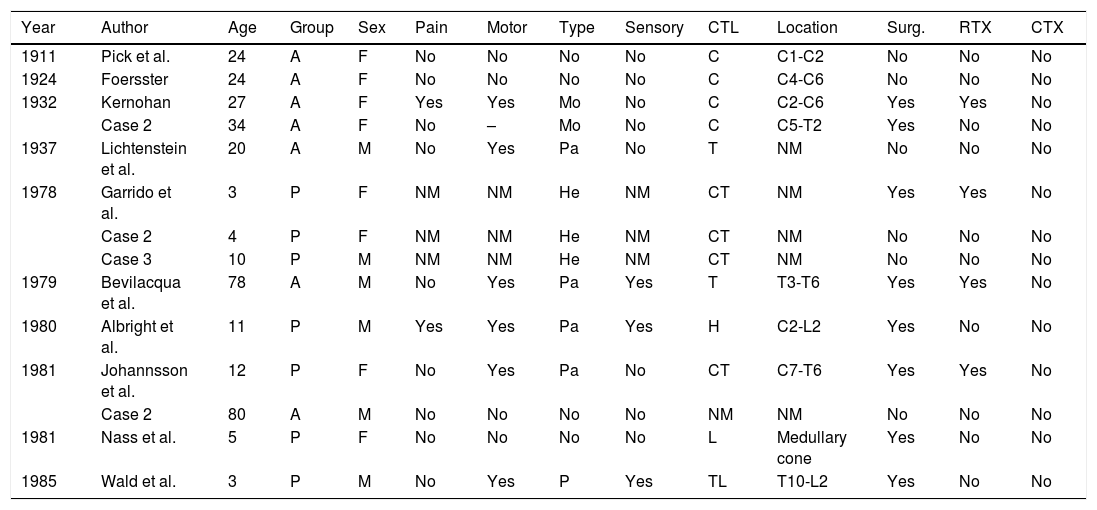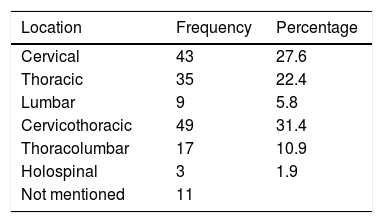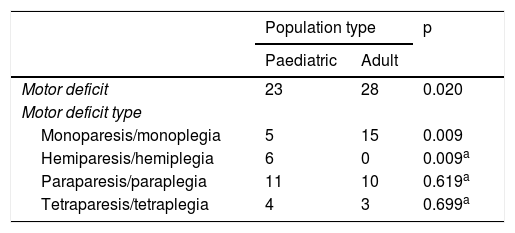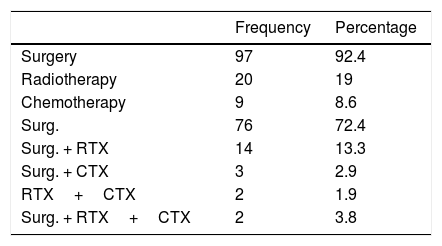Intramedullary spinal cord gangliogliomas (ISCGGs) account for 35%-40% of all intramedullary tumors in children. These tumors have a different algorithm for treatment and prognosis than other medullary tumors, such as astrocytomas and spinal ependymomas. The objective of the study was to review the literature and examine an approach to diagnosing and treating this tumor based on a case report of ISCGG diagnosed at our center.
MethodAn exhaustive review of cases of ISCGG published via the PubMed-NCBI platform between 1911 and 2018 was performed, and each patient's epidemiological characteristics, tumor location, symptoms, radiological diagnosis and treatment were appended.
ResultsA total of 167 cases of ISCGG were found, including our own. In our sample, 52% of patients were female and the most commonly affected age group was 0-9 years of age (35% of patients). Motor deficit has been found to be the main symptom in a larger proportion of adults patients versus pediatric patients. On X-ray, this tumor shows greater hyperintensity and contrast uptake than astrocytomas and ependymomas, as well as a higher percentage of intratumoral cysts. The BRAFV600E mutation is less common in spinal as opposed to supratentorial gangliogliomas. Surgery with complete resection is the treatment of choice. Only 19% of the patients in the sample received radiotherapy, and only 9% received chemotherapy as their only line of treatment.
ConclusionsISCGGs are common in the pediatric population and require strong suspicion for proper diagnosis and treatment, as the risk of recurrence of ISCGGs is three times greater than that of supratentorial gangliogliomas.
Los gangliogliomas espinales intramedulares (GGEI) representan el 35-40% de todos los tumores intramedulares en niños. Estos tumores presentan un algoritmo terapéutico y pronóstico diferente con respecto a otros tumores medulares, tales como los astrocitomas o los ependimomas espinales. El objetivo del estudio es revisar la literatura para esclarecer una vía diagnóstica y terapéutica de dicho tumor en base a un caso clínico de GGEI diagnosticado en nuestro centro.
MétodoSe ha realizado una revisión literaria exhaustiva de los GGEI publicados desde 1911 hasta 2018 a través de la plataforma PubMed-NCBI, adjuntando de cada paciente, las características epidemiológicas, la localización, la clínica, el diagnóstico radiológico y el tratamiento.
ResultadosSe encontraron un total de 167 casos de GGEI, incluyendo nuestro caso. En nuestra muestra, el 52% de los pacientes pertenece al sexo femenino, siendo la década de edad más afectada la que va de los 0 a los 9 años (35% de los pacientes). El déficit motor se establece como síntoma principal en pacientes adultos en mayor proporción que en pacientes pediátricos. Radiológicamente, este tumor se presenta con mayor hiperintensidad y captación de contraste que los astrocitomas y los ependimomas, así como un mayor porcentaje de quistes intratumorales. La mutación BRAFV600E es menos frecuente en los gangliogliomas espinales que en los supratentoriales. La cirugía con resección total es el tratamiento de elección. Solamente el 19% de los pacientes de la muestra recibieron radioterapia y solo el 9% quimioterapia como única vía de tratamiento.
ConclusionesLos GGEI son frecuentes en la población pediátrica y requieren de un alto nivelde sospecha para su correcto diagnóstico y tratamiento, ya que tienen 3 veces más riesgo de recurrencia que sus homólogos supratentoriales.
Article

If it is the first time you have accessed you can obtain your credentials by contacting Elsevier Spain in suscripciones@elsevier.com or by calling our Customer Service at902 88 87 40 if you are calling from Spain or at +34 932 418 800 (from 9 to 18h., GMT + 1) if you are calling outside of Spain.
If you already have your login data, please click here .
If you have forgotten your password you can you can recover it by clicking here and selecting the option ¿I have forgotten my password¿.














